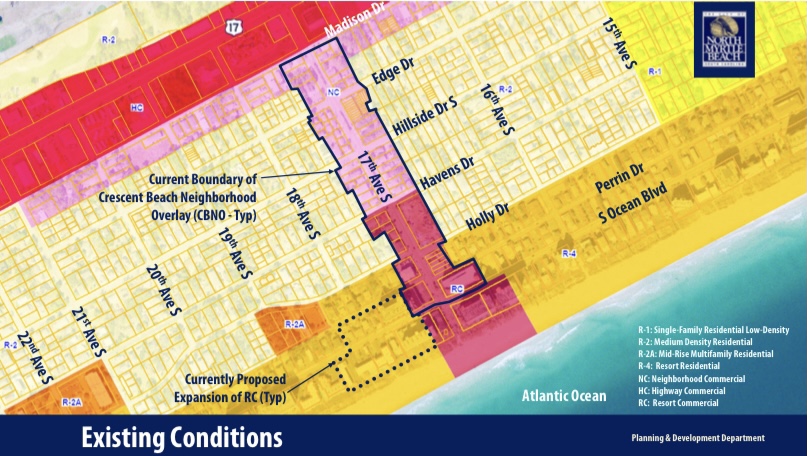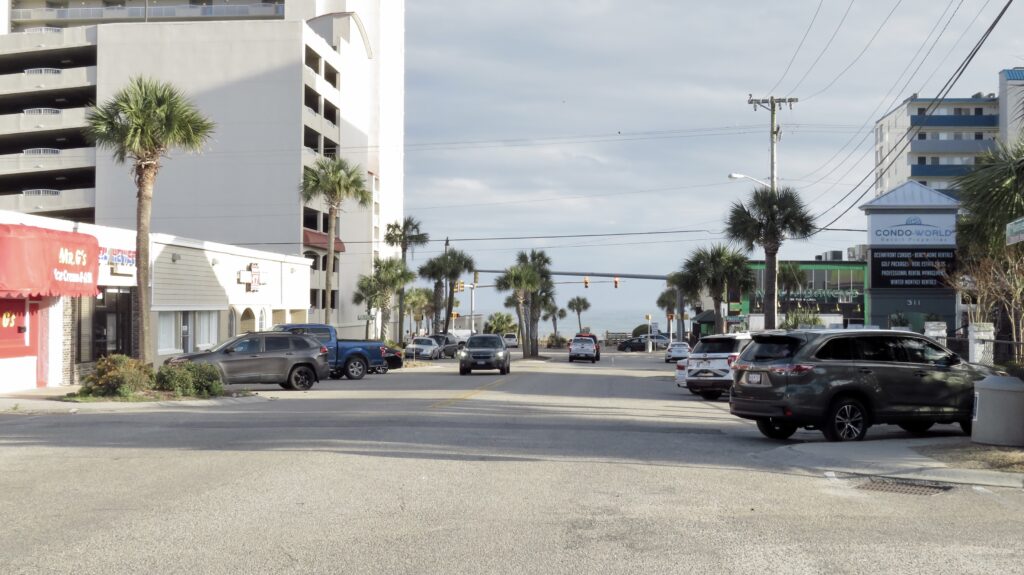By RUBEN LOWMAN
Crescent Beach will soon be getting a major re-development that may bring coffee shops or arcades to the neighborhood, along with a high-rise or two.
North Myrtle Beach City Council met on Monday, March 7, and approved the first reading of an ordinance that will see the area get some taller hotels with ground floor space that will potentially house shops, which councilmembers hope will help to revitalize a part of the city that hasn’t received major improvements recently.
“There’s been a lot of changes, a lot of modifications, and I know we still have a lot of the public that is not in favor of it, and they’ve been pretty clear about it,” Councilmember Hank Thomas said. “But I’d like to say to them that the goal on this, if you have an opportunity to reduce density, then I’d like to do it. And in this case while it’s been an arduous task and we’ve gone around in circles to get there, we’re there.”
The current overlay, which the ordinance would alter from R-4 to RC allowing more options for commercial uses, extends from Madison Drive near Highway 17 to Ocean Boulevard by way of 17th Avenue South. The new ordinance would also see the overlay zone cut in half by removing the northern section and leaving just the southern section by 17th Avenue South.

The ordinance originally came to council’s attention last year when a property owner wanted to rebuild his hotel and brought the plans to city officials. Councilmembers brought the issue up in a meeting last December, which was met with a strong opposition from residents of the neighborhood.
The original plans were for a rezoning of nearly 30 lots, making up almost 10 acres. The rezoning would have altered the area from residential to commercial. After deliberations and workshops and the plans being sent back to the planning commission, councilmembers decided to reduce the footprint of the overlay.
“And you’ve got to remember it started out with nine and a half acres, which passed first reading 4-3,” explained first-term Ocean Drive councilmember Bubba Collins. “It got postponed second reading, we listened to the citizens and we came up with this compromise.”
The new overlay plans council approved unanimously would allow hotels and resorts on the oceanfront to be built up to a maximum height of 165 feet but limit buildings across boulevard to just 90 feet. Currently, the area is zoned to permit buildings with a maximum height of 90 feet, but businesses are allowed to add up to four levels of parking to reach up to 135 feet.
Additionally, all parking garages that are built, either on the oceanfront or on the second row, will have awnings or windows to block the garages from public view. They will also be required to have their ground floor maintain at least ten percent solely for commercial. Councilmembers have expressed that businesses such as coffee shops or ice cream parlors would be a good fit for the area and the plans.
Some residents were opposed to the plans because of a variety of reasons. The height of the buildings, a possible increase in crime and safety issues, higher density, and environmental impacts and overcrowding on the beach were all given at the meetings and workshops.
“The growth’s among us,” Councilmember Trey Skidmore said. “All we can do at this point, we can’t control it, we can’t stop it, all we can try to do is manage it. And I think that this does a very good job of that.”

Councilmember Jay Baldwin said that he and Skidmore met with a group of Crescent Beach residents Saturday. One takeaway was that he thinks there’s a good bit of misinformation about the proposed overlay and what the plans will actually be.
Baldwin, who has represented the Crescent Beach section for going on two decades, said the initial plans for the revitalization stem from prior to 2006 when the city was in a recession and before the “boom” it is in now. He explained how that influenced his decision-making on the re-development.
“And there were a lot of derelict houses, a lot of homes in this area that were abandoned and there was a lot of crime and a lot drugs, and a lot of things we don’t want in our city,” Baldwin said. “And that’s what brought this about, was we were trying to figure out ways to circumvent this, be proactive instead of reactive.”
Baldwin said council created the overlay to try and entice better development, which didn’t necessarily work to plan, and they also put stricter restrictions on derelict houses, things such as homes not being allowed to have broken windows or doors that wouldn’t lock. Ultimately, he said that councilmembers and city officials want to do what’s best for the community and they feel the proposed new overlay does that.
“We don’t want more density, we want to do what our citizens want us to do, what we’re trying to do, the right thing. We’ve got to be proactive,” Baldwin said. “We’ve been very fortunate and very lucky that we don’t have the crime in our city that other neighboring cities do and we want to keep it that way.”
Councilmember Nikki Fontana echoed her colleagues comments, saying she felt it was good for the area to get a cleanup and some upgrades.
“I think it’s going to be good for that area to cleanup. This is a new property, it’s not an older property. It’s going to increase the value around there and you’re creating a livable and walkable community around there,” Fontana explained.
“And it’s going to be good for everyone, it’s not just going to benefit the people coming in to stay there, it’s going to benefit the residents that are around there too. I just think it’ll add so much more to that and kind of liven it up.”

A proposal brought by the department of public safety that would outlaw fires or any open flames on the beach, at beach accesses or the street ends at the beach was also passed on first reading by city council. The ordinance would apply to all propane grills, coolers or other heating devices.
The next regularly scheduled council meeting where both ordinances will receive second reading is for Monday, March 21, at 7 p.m.
 North Myrtle Beach Times Serving our Community and the Grand Strand for over 50 years
North Myrtle Beach Times Serving our Community and the Grand Strand for over 50 years

